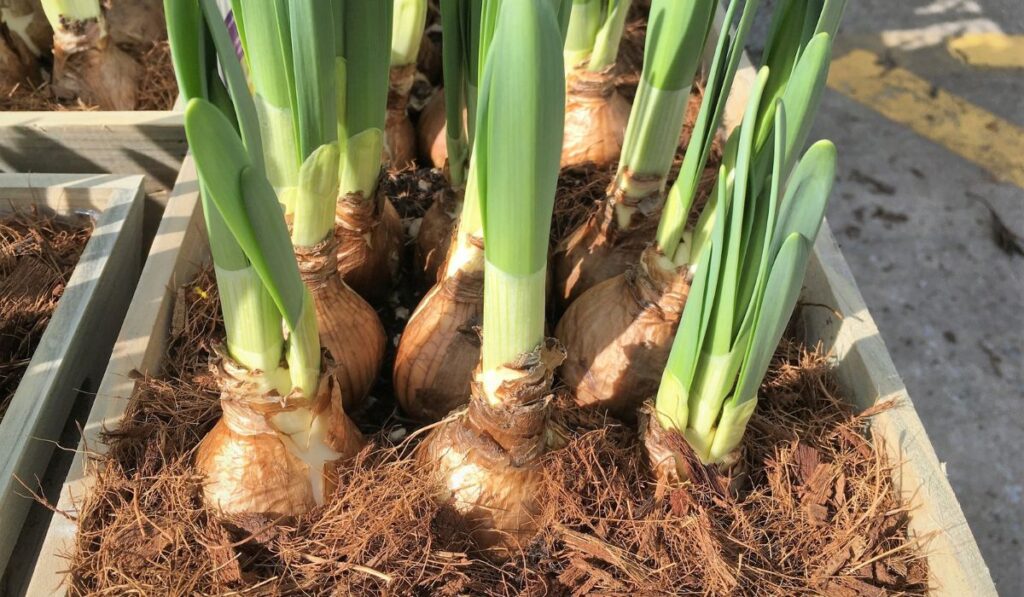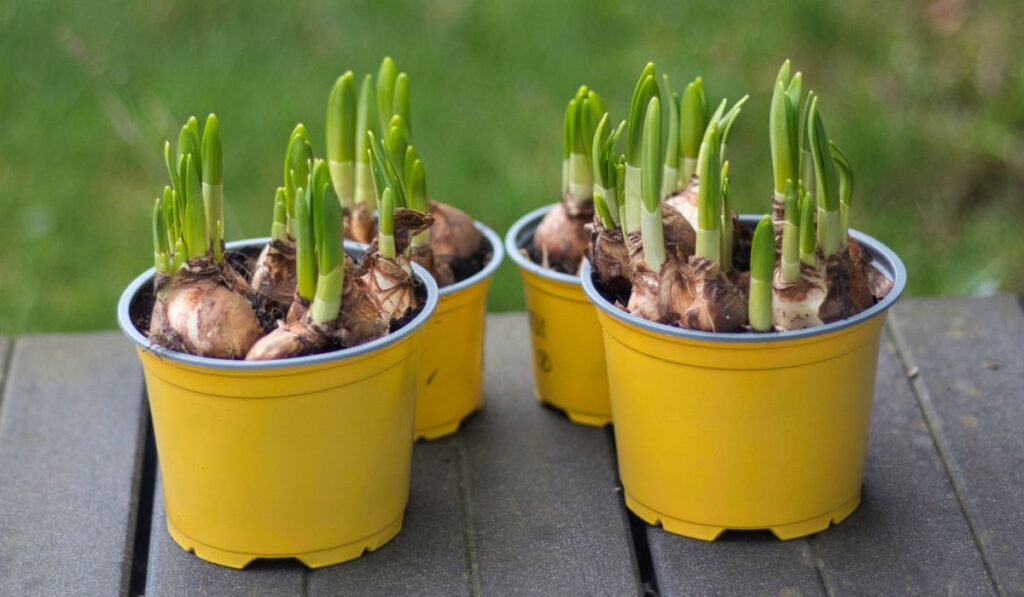The bloom of narcissus bulbs is a sure sign of spring, and these beautiful ornamentals can remarkably light up any landscape. In elegant contrasts, you can accent their snowy white, lemon-yellow, or glorious gold blooms with other flowers. But how do you plant narcissus bulbs?
The best time to plant narcissus bulbs is in the fall, a couple of weeks before the ground freezes. Plant the bulbs with their pointy ends 2 to 3 times deeper than the bulbs are high. Water them well and follow other care routines to help them thrive.
Narcissus bulbs have a delightful variety of choices that are easy to grow and won’t give you trouble with maintenance. They thrive in different climatic conditions and will bloom consistently through the years. Let’s get started so you know everything about planting these spring-flowering perennials.
What are Narcissus Bulbs?
Narcissus is a genus of predominantly spring-blooming perennial bulbs of the amaryllis (Amaryllidaceae) family. People use common names like daffodil, paperwhite, or jonquil to refer to members of this family. They’re hardy plants that usually bloom in early spring or late winter.
Most narcissus bulb varieties like this one (on Amazon) have a lemon-yellow or prominent white color, with six petals surrounding a trumpet-shaped corona. You may also find frilled or bicolor varieties with peachy pink and orange accents.
Some narcissus cultivars have multiple stems per bulb, and others produce dramatic flower clusters on these stems. Moreover, they have different fragrances, with certain types producing anything from a sweet floral note to a heavy musk.
Most daffodils do well in various regions, except in the hottest, wettest areas like South Florida. You can plant narcissus bulbs on a border, between shrubs, or even in your garden pots.
You’ll love them in large groves and your woodland garden, but you can also force them inside to cheer up your winter months.
What are the Different Types of Narcissus?

There are dozens of narcissus bulb varieties and thousands of cultivars, and these are the most common types:
Trumpet Daffodils
Trumpet daffodils are the classical spring-blooming narcissus bulbs, and their single, big, bold flowers make them ideal for bedding. While some gardeners plant them in the Deep South, they typically do best in the northern and middle states.
A trumpet daffodil has its cup, or corona, longer than the perianth or the same size as it is. Common varieties of trumpets include the award-winning “Mount Hood,” “King Alfred,” and “Dutch Master.”
Double Daffodils
These narcissus varieties have a central cluster of petals and are more roselike than the trumpet types. Doubles may have a whopping 20 flowers per stem, making them suitable for shows, cutting, and bedding.
Jonquilla Daffodils
Jonquillas have small, sweet-scented flowers on their stems above narrow, dark green leaves. The bulbs naturalize incredibly well, creating astonishing sweeps of color. Jonquillas aren’t intimidated by the hot, baking summer sun, but they can also thrive in cooler parts of the country.
Large-Cupped Daffodils
Large-cupped daffodils are a gardener’s favorite, as they’re versatile and won’t disappoint you in uses like bedding, forcing, cutting, and showing. They bear a single flower per stem, with a couple of stems per bulb.
And if you’re looking for daffodils with a full-color range, you’ll undoubtedly find these with every shade of yellow, red, pink, and orange.
Small-Cupped Daffodils
This class of daffodils occurs in brisk, dazzling colors. They’re suitable for naturalizing and can offer a rich contrast to a mixed border in the spring. Each stem produces a single flower, and they’re great for cutting.
Miniature Daffodils
Miniature daffodils include every bit of narcissus in a petite, 6-inch package, and others are smaller. They work great for rocky gardens, niches between tree roots, and border fronts. You can also have them in patio containers.
While the petite bulbs vary in size, most are the largest grade available, with each bulb bearing two or more stems.
Split-Corona Daffodils
Split-corona daffodils are a bit unusual, with the cup split for at least half its length, creating an open face resembling a Hibiscus. While they don’t resemble trumpets like other kissing cousins of daffodils, these large, upward-facing blossoms are the showiest for mass plantings in your landscape.
When to Plant Narcissus Bulbs
The best time to plant narcissus bulbs is in the fall, some 2 to 3 weeks before the ground freezes. You can plant them anytime from August to November when the soil is cool but not frozen.
Since these bulbs love the sun, select a spot that will receive full sun, which is no less than 6 hours of sunlight per day. The simplest way to plant daffodils is by scattering them across the well-prepared ground. Here are some quick, valuable tips for planting them:
- Plant the bulbs with their pointy ends about 2 to 3 times deeper than the bulbs’ height. So if you have a 2-inch bulb, set its pointy end 4 or 6 inches in the ground.
- Where the winters are extreme, gently cover the bulb with at least 3 inches of soil.
- While daffodils can tolerate some crowding, you should thin them so they have a spacing of 3 to 6 inches apart.
The bulbs will sprout from the ground by themselves in early spring, rewarding you awesomely with their colorful blossoms year after year.
How to Care for Your Daffodils
Daffodils require very little maintenance, and you can help them thrive and thrive by following these simple tips:
- If the bulbs aren’t performing as you desire after a bloom, apply a low-nitrogen fertilizer with high potash content.
- It’s not uncommon for flowers to abort in dry conditions, so be sure to water late-flowering narcissus plants in dry spring weather. However, don’t water excessively in the summer months when the bulbs are dormant.
- Lift and divide the clumps when there’s less blooming or the clumps get packed up.
- You want a neat garden appearance, so deadhead the plants as flowers fade and allow leaves to remain for about six weeks. Then, snip off dead plants at the base or carefully twist the leaves while pulling tightly to remove them.
- After the plants bloom in the spring, allow them to grow until they die off. Please resist the temptation to cut them down earlier, as they need time to store energy in the bulbs for the next bloom. And once the bulbs have gone by, you can add bone meal to the soil for the following year’s blooms.
- If you’ve planted narcissus bulbs on your lawn, wait until the bulb foliage begins to turn yellow before you can mow the grass. And when you cut the long grass, remove all debris so it won’t degrade and enrich the grass itself in a way that takes a toll on next year’s bloom.
- While daffodils do well under deciduous trees, you shouldn’t plant them under evergreens and in areas with large roots near the ground surface.
- If you spot vertical streaks in the bulbs’ leaves, it’s more likely that a virus has infected the plants. Dig up the bulbs and discard them in the trash immediately. Monitor surrounding plants for similar symptoms because such viruses typically spread by contact.
- The best time to divide or transplant narcissus bulbs is when their foliage has withered to signal the end of active growth. Carefully lift the bulbs with a spade or digging fork and transplant them immediately at the same depth. Water them well.
- If snow or frost causes your blooming daffodils to lean over, your best bet is to avoid touching them, as they’ll thaw out naturally. But if you handle them while frozen, you risk causing the plant cells to rapture.
Things to Know Before Planting Narcissus

Choose larger, high-quality narcissus bulbs that have not been dried out because they usually do better. Before planting daffodil bulbs, here’s what to know about preparing the planting site:
- While narcissus bulbs can grow in partial shade, they do best in sites with full sunlight.
- Daffodils may not be picky about the soil type, but proper drainage is critical. They’ll quickly rot if the soil is too wet, so establish them in a well-draining spot. If your area has clay, improve it with 12 inches of well-rotted compost or aged manure.
- The bulbs do well on hillsides and raised beds and like slightly acidic soil.
- Regarding potential danger to pets, ensure your animals don’t munch on them as they’re toxic. Moreover, deer and rodents don’t like them for this reason.
- You’ll need to wear safety gloves when handling daffodils because their leaves contain crystals of calcium oxalate, which, together with their sap, can irritate your skin or provoke allergies.
